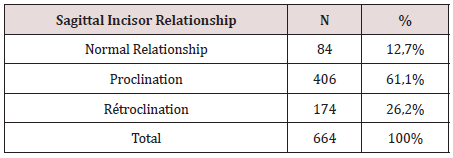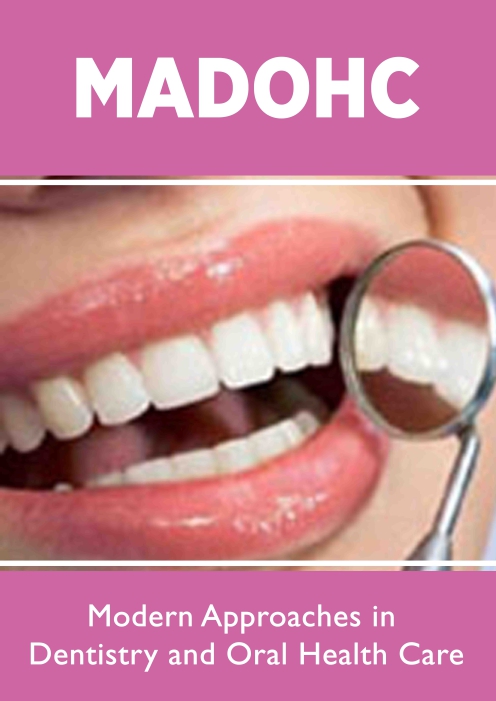
Lupine Publishers Group
Lupine Publishers
Menu
ISSN: 2637-4692
Research Article(ISSN: 2637-4692) 
Prevalence of Incisor Relationship Anomalies in an Algerian Orthodontic Population: Influence in Frequency of Orthodontic Extraction Volume 3 - Issue 4
Farida Ammouche*
- MUHC Algiers, Algeria
Received:May 17, 2019; Published: May 23, 2019
Corresponding author:Farida Ammouche, MUHC Algiers, Algeria
DOI: 10.32474/MADOHC.2019.03.000170
Abstract
In a study of therapeutic extractions in orthodontics, incisor relationship anomalies were described in the three planes of space: transverse, vertical and sagittal planes. 664 patients were considered among them, a large number had occlusal disorders in the anterior sector: we mainly observed midline discrepancies (69,6%), deep bite (48%), open bite (27,6%), proclination (61,1%), retroclination (26,2%). Incisor relationship intervenes in our therapeutic choices, particularly with regard to extracting or not, but can be an indicator in favour of screening and early treatment.
Keywords: Incisor relationship anomalies, Three planes of space, Therapeutic choices
Introduction
Incisor relationship anomalies are the main reason for consultation among our patients, especially when they are associated with dental crowding. The reason is that the impact is felt on the aesthetic of the smile essential parameter of the demand for orthodontic treatments [1]. The clinical form and degree of severity [2,3] depend on the etiological factors and the relevant dentoalveolar or skeletal structures involved in the onset of incisor relationship abnormalities. The therapeutic approach is chosen considering these factors but also the age of the patient and the stage of growth. In most cases, it is preferable to opt for early treatment mainly when the problem is dentoalveolar or functional, the chances of success are greater in the short and long term [4,5].
Thus, when the treatment is late, extraction can be necessary to correct the incisor relationship anomalies mostly if dental crowding or skeletal malocclusions are associated.
Material and Method
Our study involved an Algerian orthodontic population of 664 subjects (372 girls and 292 boys). All individuals meeting the inclusion criteria were selected. Mean age was twelve. Patients were excluded if they had primary dentition, lost permanent teeth or were more than 16 years old. Incisor relationship has been raised for the entire population in the three planes of space. The calculation of the percentage of occlusal anomalies was made to describe the sample and evaluate the frequency of orthodontic extraction. The incisor relationship was examined and measured by referring to the midline for transverse plane, the overbite for vertical plane and the overjet for sagittal plane. The frequency of extraction had been evaluated considering the incisor relationship.
Results
Among the total patients included in this study, the frequency of orthodontic extraction was 52,6%, 349 patients had been treated with extraction of definitive teeth. The prevalence of incisor relationship anomalies differs from one plane of space to another. The results showed a major percentage of individuals with incisor midline discrepancies in our selected group (69,6%). Deep bite was also predominant in our sample, 48% of patients had an exaggerated overlap. In the sagittal plane, results showed the predominating of incisor proclination with a rate of 61.1%. The percentages of extractions vary according to the type of anomalies but are more important in cases of midline discrepancies and incisor proclination (Tables 1-4).
Table 4: Extraction Percentages in Incisor Relationship Anomalies Among the Group Treated with Extraction (N=349).

Discussion
The frequency of orthodontic extraction among the total sample was 52,6%. Incisor relationship anomalies prevalence is important but different from a plane to another: transverse 69,6%, vertical 75,6%, sagittal 87,3%. The study showed that the criteria for extraction concerned mostly the dental crowding and class II skeletal malocclusion [6]. So, the variability of extraction percentage in incisor relationship anomalies can be explained in different ways. It is possible to consider the aesthetic as an influencing criterion in the decision to extract since the incisor relationship affects the smile and the profile [7]. But it can’t be the only explanation. Midline discrepancies, deep bite, proclination are the most numerous among our patients and the most concerned in extraction, the lack of space on the dental arches may explain the decision to extract. This is in keeping with the fact that incisor relationship anomalies are often associated with skeletal malocclusions or dental crowding [8,9]. The incisor proclination when pronounced requires a large incisor repositioning and consequently space on the arches. Often associated with Class II skeletal discrepancy and dental crowding, the exaggerated overhang is corrected by dental extractions and incisor recoil. Concerning midline discrepancies and deep bite, the same conclusions can be drawn although there may be contraindications for deep bite: extraction is related to the amplitude of the deviation and the presence of various associated anomalies.
So, in all cases, the results showed orthodontic extractions justified by usual criteria [6,10] but late treatment knowing that the mean age among the population was twelve and the insufficiency of early and functional therapies may explain the high percentages of extraction too [11,12].
Conclusion
Our study showed a high prevalence of incisor relationship anomalies and high percentages of orthodontic extractions. The reason for extraction varies according to each clinical case. Differences in the clinical form of malocclusions may help to understand those related to the therapeutic choice mostly when extraction is indicated. This can be related to the impact of anomalies on the aesthetic of the smile and profile but also to the associated anomalies which are dental crowding and skeletal malocclusions. Moreover, when the treatment starts late, it is done with more extraction because the possibilities of gaining space decreases when anomalies are severe. So, the conclusion is that to reduce the frequency of orthodontic extraction, it is necessary to prevent the appearance of these anomalies or to intercept them early using alternative therapies as expansion or molar distalization.
References

Top Editors
-

Mark E Smith
Bio chemistry
University of Texas Medical Branch, USA -

Lawrence A Presley
Department of Criminal Justice
Liberty University, USA -

Thomas W Miller
Department of Psychiatry
University of Kentucky, USA -

Gjumrakch Aliev
Department of Medicine
Gally International Biomedical Research & Consulting LLC, USA -

Christopher Bryant
Department of Urbanisation and Agricultural
Montreal university, USA -

Robert William Frare
Oral & Maxillofacial Pathology
New York University, USA -

Rudolph Modesto Navari
Gastroenterology and Hepatology
University of Alabama, UK -

Andrew Hague
Department of Medicine
Universities of Bradford, UK -

George Gregory Buttigieg
Maltese College of Obstetrics and Gynaecology, Europe -

Chen-Hsiung Yeh
Oncology
Circulogene Theranostics, England -
.png)
Emilio Bucio-Carrillo
Radiation Chemistry
National University of Mexico, USA -
.jpg)
Casey J Grenier
Analytical Chemistry
Wentworth Institute of Technology, USA -
Hany Atalah
Minimally Invasive Surgery
Mercer University school of Medicine, USA -

Abu-Hussein Muhamad
Pediatric Dentistry
University of Athens , Greece

The annual scholar awards from Lupine Publishers honor a selected number Read More...







